Seeking Spirituality in the North Cascades
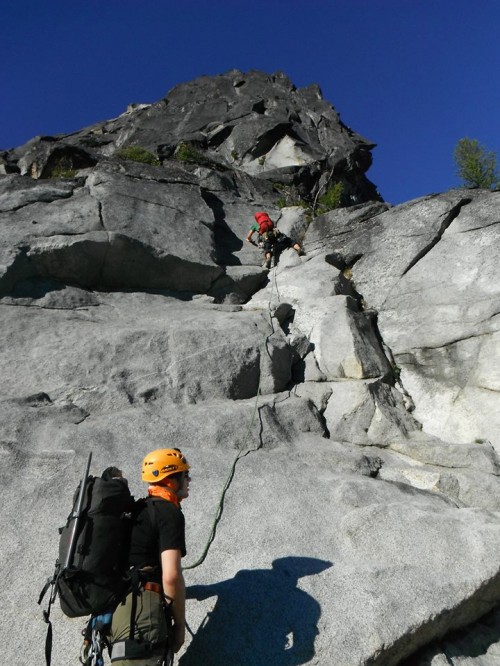
I watched quietly as each bend in the road revealed more of the steep, inaccessible wilderness that looms above Highway 20. It was my first couple of hours in the North Cascades and I wanted to get up high, to see around. From Washington Pass I glimpsed Silver Star Mountain through the swirling clouds as the other tourists and I chuckled at the futility of an overlook in a raincloud.
The terrain and weather of the North Cascades are renowned amongst alpine climbers. Four or five years ago I thumbed through the legendary climber Fred Beckey’s three volume guide to North Cascades climbing and filled my head with images of peaks and glaciers, as well as stories of loose rock and freak snowstorms.
Yet I hadn’t come here to climb. Instead, I was here for an internship, to live and learn how to teach ecology to a bunch of crazy kids with the naturalists and educators of the North Cascades Institute. Well…maybe I was here to do a little climbing. Living just down valley from the Institute, in Newhalem, put me less than ten miles south of one of the most rugged mountain ranges in the Lower 48, the Picket Range. I at least wanted to go and look at it.
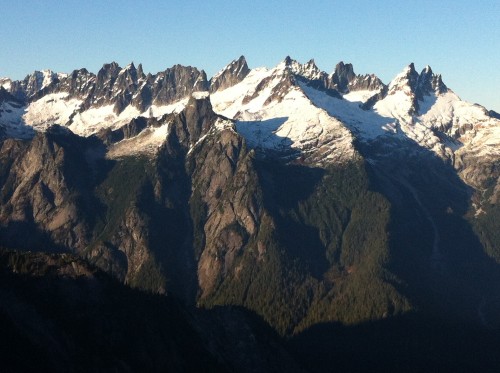 A Cascadian fence: The Picket Range, a climber’s paradise, as seen from Trapper’s Peak. Photo by Dylan Harry.
A Cascadian fence: The Picket Range, a climber’s paradise, as seen from Trapper’s Peak. Photo by Dylan Harry.
As I began to work and play with the residents of the Upper Skagit valley, I experienced a distinct shift in my experience of the outdoors. Standing in that cloud in Washington Pass, I knew that my climber self would be able to connect to the North Cascades. Over the course of a rainy September, however, I was forced to seek new ways to connect to the landscape and community. In reflecting on this change in myself, I found the fourfold path of Hinduism to be a useful lens, despite my near complete ignorance of Hinduism.
Before coming to NCI, most of my outdoor teaching was adventure-based: climbing, whitewater kayaking and backpacking. In my free time I liked to go trail running and mountain biking, and I regarded nature as a place to be challenged physically. After a leisurely stroll in the woods, I would say, “That was really nice, just to be outside breathing fresh air,” while actually thinking, “That was really boring, I need to go for a run.” What I found at NCI was a group of people that explored and appreciated nature in a broader sense.
Some of my new friends liked to spend hours hiking a mile, identifying every fungus and flower along the way. Some would just go out by themselves to listen for birds or to look for a moose. They didn’t keep track of how many birds or moose they saw, and didn’t measure the success of the day on tangible metric. One rainy afternoon I discovered the joy of collecting edible chanterelle mushrooms, which became a warm mushroom and wild rice soup. I recognized the satisfaction that can be found in slowing down and looking around.
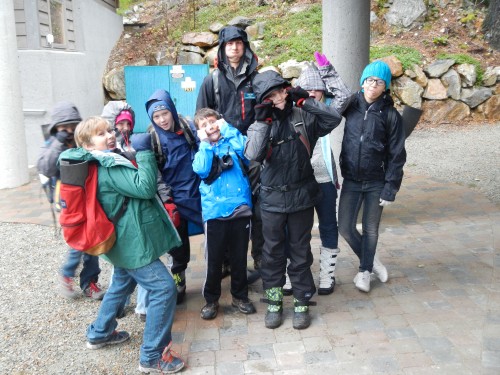 Smiles and crazy faces abound in Dylan’s trail group. Photo by Matt Kraska.
Smiles and crazy faces abound in Dylan’s trail group. Photo by Matt Kraska.
During the fall season, NCI brings 4th-8th graders into the woods around the Institute to have fun learning the principles of ecology. Seeing a Douglas squirrel or a piece of quartz through the eyes of an 11-year-old is an awesome experience. It brings me back to my childhood days of building forts and collecting rocks. On the trail with the group, I rarely break a sweat, yet I find I am smiling. You can’t help but laugh with students who take waterproof hiking boots as an excuse to wade knee deep into a creek, or who go through a buffet line of salads and vegetables only to end up with mac and cheese, shredded cheese and cottage cheese for dinner.
John Muir once wrote, “The clearest way into the Universe is through a forest wilderness.” My new friends and modes of exploration remind me of the four paths to the Universe as described by Hindu tradition. According to Hinduism there are four spiritual paths to Oneness with the infinite being, although a person may choose to combine several paths to suit their unique conditions.
Karma Yoga is the path of selfless labor or physical work. The energy that my fellow educators pour into their lesson plans and trail activities reminds me very much of karma yoga. During stewardship days with Bellingham Parks and Recreation, we spend hours pulling out invasive species with the students, rain or shine. This simple, physical job – another form of karma yoga — spreads satisfaction from the students to their communities.
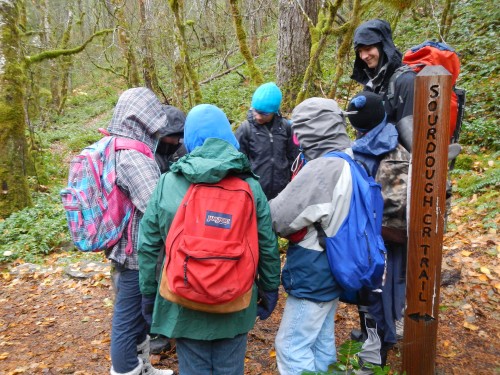 Another path all the educators and students at Mountain School inevitably travel — the Sourdough Creek Trail. Photo by Matt Kraska.
Another path all the educators and students at Mountain School inevitably travel — the Sourdough Creek Trail. Photo by Matt Kraska.
Jnana Yoga is the path of knowledge. It involves devotion to the Hindu spiritual texts and the denial of the physical self. This path is a difficult one, and often requires extended periods of isolation. This reminds me of the scientists and their research that provide a foundation for our teachings at NCI. Although many of the naturalists seek and enjoy obtaining new knowledge of their surroundings, we often focus on observation, plunging into the realm of the sensuous rather than denying this corporeal world. This is perhaps a reaction against academia and the isolation from nature that plagues modern Americans.
Astanga, or Raja, Yoga seeks to leave the material realm by achieving eight mystic powers. These are accomplished through movement and meditation. Yoga, as perceived by most of Western culture, is derived from this path. Also, Buddhist meditation could be considered a form of Raja Yoga. I enjoy this yoga; the mental space found during a difficult climb or section of trail is my meditation. I see improvements in my physical achievements as proof that my lifestyle and mental state are properly aligned.
And lastly, Bhatki yoga is the path of devotional service. In Hinduism, this involves selecting one of the Hindu deities as an object of worship. Christianity and Hare Krishna could both be considered forms of Bhatki Yoga, or love meditation. I think many of the instructors at NCI ascribe to this final yoga because it is can be shared with a 5th grader. When we enthusiastically engage in an exploration and love of nature, the children and their parents often become engaged as well. It is our best teaching tool. We also have a love of our human community, which permeates our work and play. Engaging daily in an appreciation of community and nature through teaching has had a profound effect on me.
Through this fall season teaching in the North Cascades, I have rediscovered a path that is satisfying and involves, but does not revolve, around climbing. It involves people, laughing and food. It involves playing silly games with 5th graders and looking for mushrooms without actually finding them.
When you live at the feet of big mountains, they provide a sense of mystery and humility. When you stand atop a big mountain, you are usually thinking about getting a warming drink back down in the valley. I learned that the valley is where the miracles of everyday living and learning happen, where many people choose to carry out their yoga.
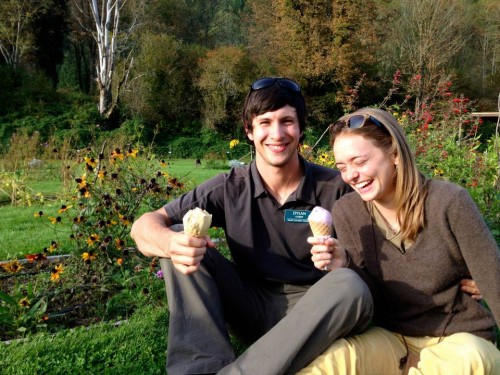 The “miracles of everyday living and learning” certainly include local ice cream: The author and Lily Morgan enjoying some free scoops at Cascadian Farms after a day of representing the North Cascades Institute at the Skagit Festival of Family Farms (WE MISS YOU GUYS! –ed.).
The “miracles of everyday living and learning” certainly include local ice cream: The author and Lily Morgan enjoying some free scoops at Cascadian Farms after a day of representing the North Cascades Institute at the Skagit Festival of Family Farms (WE MISS YOU GUYS! –ed.).
Leading photo: The author and his friend, Jared, starting a 24-hour car-to-car ascent of the Direct North Buttress of Mt. Stewart in the Enchantments. Photo by author.
Dylan Harry recently completed a seasonal internship with the North Cascades Institute where he spent most of his time trying to convince the students that he was neither Justin Bieber nor Andy Samberg, and that yes, he was old enough to be a teacher. Trained as a scientist and climbing bum, he aspires to teach ecology to anyone that will listen to him.


Wonderful, Dylan! I love your unique voice and spiritual take on this beautiful place we share.
Word! The valley is where the miracles happen.
I am also settling into a life that “involves but does not revolve” around slaying the alpine dragon and I find comforting wisdom in your words. Stay cool and play music.
Dylan, what a WONDERFUL post! I have often found parallels to Hindu tradition in the work that we do myself, and am so glad to read a post that explores this kind of spiritual-nature dualism. This post rings with your voice, your insight, and your reflective spirit.